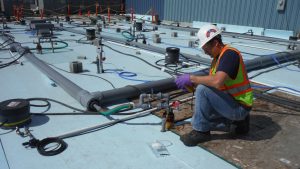Well 12A
KEMRON completed two source removal projects at the Well 12A Superfund Site in Tacoma, WA, a former oil recycling facility where off-site migration of chlorinated solvent-contaminated groundwater impacted Tacoma’s drinking water well.
During the first phase, KEMRON was tasked to excavate approximately 500 cy of filtercake and soil estimated to contain greater than 10,000 ug/kg CVOCs. Although a small UST was thought to be present at the site, the geophysical surveys identified a buried rail tank car filled with pea gravel and product. KEMRON sampled and tested the product and the pea gravel from the tank car and both were found to be hazardous for lead and chlorinated solvents. After shearing the top of the tank, KEMRON excavated approximately 40 cy of hazardous pea garvel to two rolloff boxes for transport to a permitted RCRA landfill. Approximately 1,700 gallons of product and 5,000 gallons of contaminated rinsewater were pumped to a tanker truck and disposed at an offisite hazardous waste disposal facility. The steel tank was cut and transported offsite for recycling. As part of our green remediation best management practices, KEMRON recycled a total of 8.0 tons of steel and 1.4 tons of concerete under this phase of work.
Soil waste characterization samples collected from the excavation footprint indicated that a approximately 800 cy of soil in the north area was contaminated with chlorinated solvents at levels exceeding the RCRA Subpart CC threshold of 500 ppm VOCs, requiring incineration at an additional cost to the Government. KEMRON quickly developed an ISCO approach for the north area soil to reduce the concentrations to below 500 ppm so that the waste could be transported and disposed at a hazardous waste landfill as planned. USACE approved the cost-effective alternative. KEMRON excavated and direct-loaded to the Subtitle C landfill approximately 700 cy of soil in the south area that did not require treatment. The contaminated soil/filtercake in the north area was then treated with persulfate in six-inch lifts at a dosage of between 2-10% by weight, depending on degree of contamination. Lime was applied as an activator. After each 6-inch lift was thoroughly dry-mixed with the excavator, KEMRON spread the lift in the south area excavation and applied water to facilitate the reaction. The process was repeated until all of the soil in the north area was treated. KEMRON monitored the effectiveness of the treatment with field test kits and after approximately two months, analytical testing confirmed the treatment goals had been met. An excavator direct-loaded the treated soil/filtercake to trucks, which hauled the waste to the Subtitle C landfill. During treatment and excavation, perimeter air monitoring was performed and surfactant sprayed on the excavation surface to mitigate release of noxious organic vapors in this active commercial area.

The second phase of the project consisted of the demolition of the building overlying the source area and the implementation of ISTR, the primary source removal technology for the site. The bulding demolition required abatement of hazardous building materials (HBM) including asbestos, lead paint and PCB caulk. In accordance with the Green Remediation Plan, KEMRON abated the HBM and recycled remaining materials, including large timber beams, that did not require landfilling.
KEMRON employed electrical resistive heating (ERH) as the ISTR technology for the Well 12A site. The performance objectives for the ISTR was 90% reduction in mass of the six primary CVOCs with a mean concentration of 17.0 mg/kg within a 27,900 cy treatment volume. The subsurface system consisted of 71 electrodes, 35 multi-phase extraction (MPE) wells, 18 vapor extraction points, and 27 temperature monitoring points to a depth of up to 57 feet bgs installed both inside and outside an existing warehouse. Surface installation of the system included a 4,5000 kW power control unit, six step-down transformers, two 40 hp blowers and condensers/cooling towers, vapor/liquid separator, 18,000-gal. oil/water/DNAPL separator, two 1,000 lbs. liquid GAC vessels, three 8,000 lbs. vapor GAC vessels, and one KMn vapor polishing vessel along with a comprehensive system monitoring and control system.
After bringing in power and performing safety checks, KEMRON initated sytem start up. During operation, KEMRON conducted vapor monitoring of the treatment system daily and sampled the vapor treatment system using Tedlar bags and quick turn TO-15 analysis twice weekly. VGAC usage exceeded USACE’s estimates as a result of substantial concentrations of petroleum consituents in the vapor phase. KEMRON closely monitored the vapor treatment and replaced VGAC and KMn to ensure substantive requirements were met. Liquid management included skimming and containerizing LNAPL from the separator and water treatment sampling. After 117 days of operation the system was idled for post-treament sampling to verify the performance objectives were met. The sampling confirmed that the mean concentration of CVOCs over the treatment volume was reduced by 94.7%. Additionally, over 500,000 gallons of contaminated groundwater and condensate were treated at the site via the liquid treatment system, removing 1,790 gallons of LNAPL, and 55 gallons of DNAPL. The DNAPL was disposed as hazardous waste, however the LNAPL was used for fuel blending as another example of green remediation. All substantive air and water discharge criteria were met.